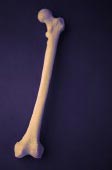
TUESDAY, Sept. 14 (HealthDay News) — An expert panel concludes that bone-strengthening bisphosphonate drugs such as Actonel, Boniva and Fosamax can actually raise risks for a rare type of fracture of the thighbone.
The panel is urging the U.S. Food and Drug Administration — which has been awaiting the report — to add a special warning to that effect on the drugs’ labeling.
“Bisphosphonates may be related to atypical femur fractures,” said Dr. Elizabeth Shane, a professor of medicine at Columbia University’s College of Physicians and Surgeons in New York City. She is the lead author of the report, which was compiled by a special task force at the American Society for Bone and Mineral Research.
“These fractures are very unusual,” Shane added. “But we are still concerned that patients could still have these fractures. There may well be a link between these fractures and bisphosphonates.”
The FDA has been given a copy of the panel report for review, she said. The findings are published Sept. 14 in the Journal of Bone and Mineral Research.
Bisphosphonates — a class of prescription medications use to treat osteoporosis — have been shown to lessen the odds of getting common bone fractures of the hip and leg. However, they may also help trigger a weakness that makes a particular type of thigh bone fracture more likely in rare cases, the panelists said.
There has been conflicting evidence on a such a link, however. For example, one study published in 2008 in the New England Journal of Medicine did find a correlation between the long-term use of Fosamax and atypical fractures in postmenopausal women. But a study published this March in the same journal seemed to refute the connection.
The FDA had looked to the expert panel to help provide some clarity. The
group’s new recommendations came after a thorough review of 310 of these atypical thigh fractures. In that review, the panel found that 94 percent of these patients had taken bisphosphonates. Most had taken the drugs for five years or more.
Shane noted these fractures are so unusual that they make up less than 1 percent of all hip and thigh fractures.
In addition, the international task force reviewed published and
unpublished data and talked with scientists at pharmaceutical companies that sell the drug. They also looked at data in the FDA’s MedWatch database, which tracks side effects of approved drugs.
In their report the panel is recommending that the FDA:
- Change the product’s labeling to alert doctors and patients to the risk of these fractures and their warning signs.
- Develop new diagnostic codes for these fractures that will improve reporting of these cases.
- Establish an international registry of patients with these fractures to track cases and provide data for research.
Shane said the panel was concerned about the lack of patient awareness of atypical femur fractures and their warning signs. These signs include groin or thigh pain for a period of weeks or months before fractures. More than half the patients experienced these signs before their fracture, the report notes.
Moreover, more than a quarter of the patients who had an atypical thigh fracture in one leg had a similar fracture in the other leg, she added.
People who are taking bisphosphonates should continue to take them, Shane said, but ask their doctor about the risk of an atypical thigh fracture. The panel added that bisphosphonates should only be given to people with certain cancers, Paget’s disease (a rare bone ailment) and patients with osteoporosis who are at high risk of having a fracture.
Millions of people, mostly women, have been treated with bisphosphonates since they were approved in 1995, Shane noted.
Bisphosphonates include: Aclasta, Actonel, Aredia, Bondronat, Boniva, Didronel, Fosamax, Fosavance, Reclast, Skelid, and Zometa.
J. Edward Puzas, senior associate dean for basic research and professor of orthopedics at the University of Rochester School of Medicine and Dentistry in New York, said that “the scientists and clinicians that made up the panel are some of the most knowledgeable and respected individuals in our field.”
He believes that while bisphosphonates may be associated with atypical thigh fractures, their benefits in treating osteoporosis and the common fractures that are attributed to bone loss far outweigh the risk of these rare fractures.
More information
For more on osteoporosis, visit the U.S. National Library of Medicine.

